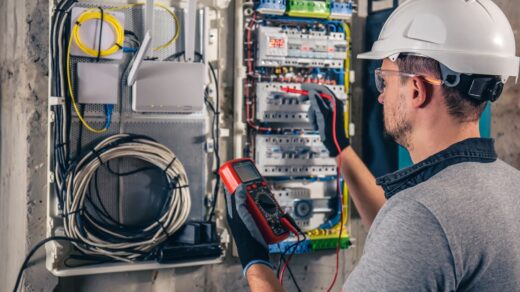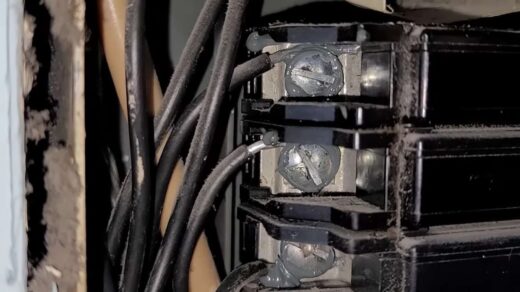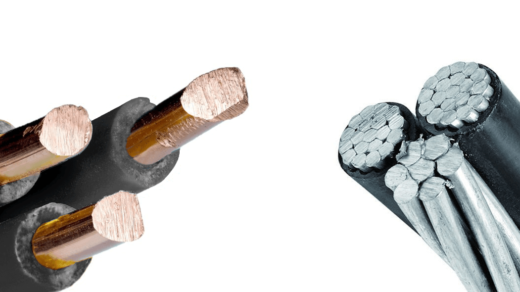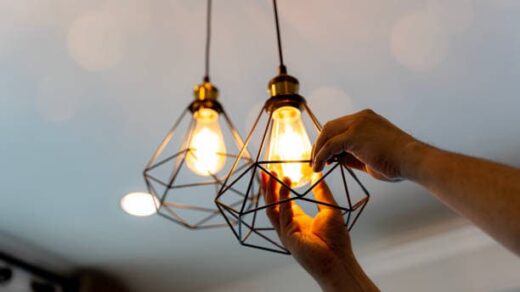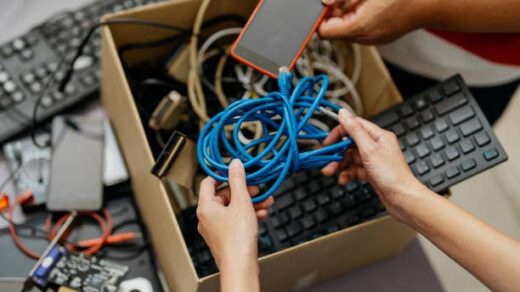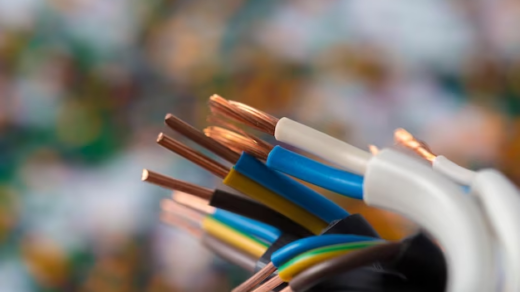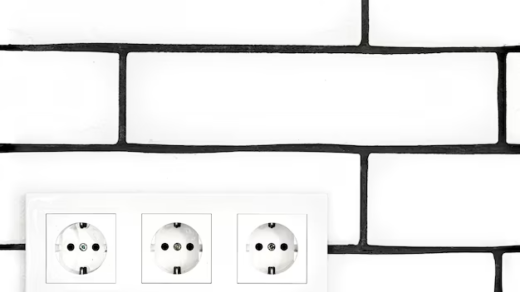Television and Entertainment Units
When it comes to arranging your living room or family room, strategic outlet placement can make a world of difference. Whether you’re a movie buff or a gaming enthusiast, having the right outlets in the right places can enhance your entertainment experience and keep your space tidy.
- Behind the TV Stand: It’s essential to have at least one outlet located discreetly behind your TV stand. This is not only for your television but also for other electronics such as game consoles, sound systems, Blu-ray players, and streaming devices. Keeping these cords hidden will create a clean and organized look;
- Expanding Electrical Accessibility: Don’t limit yourself to a single electrical outlet. Ponder the idea of incorporating extra power sources in the vicinity of your entertainment center to cater to all your electronic devices. Doing so will eliminate the necessity for unsightly extension cords and power strips that can mar the aesthetics of your living space;
- Cable Management: Invest in cable management solutions like cable clips or sleeves to keep wires neat and prevent tripping hazards. Velcro ties and cable raceways can help bundle and hide cords effectively.
Seating Areas
Your seating arrangement plays a pivotal role in determining outlet placement in your living space. Here are some considerations to keep in mind:
- Floor Outlets: If you have a centrally located seating arrangement away from walls, consider installing floor outlets. These outlets discreetly rise from the floor and provide power without cords stretching across walkways, maintaining both safety and aesthetics;
- In-Wall Outlets: For seating areas against walls, consider installing outlets slightly above floor level. These outlets blend seamlessly with your decor and provide easy access for charging devices or plugging in lamps.
Integrate electrical outlets equipped with integrated USB ports into your seating area for the utmost convenience in charging your smartphones, tablets, and various other USB-powered devices right at your fingertips.
Upgrading Your Kitchen: Strategic Outlet Placement for Maximum Efficiency
The Quintessential Countertop
The kitchen is often referred to as the home’s beating heart. A major facet of its efficiency hinges on the strategic placement of electrical outlets to cater to a plethora of appliances and gadgets. Dive deep into enhancing your kitchen’s electrical dynamics with this guide:
Countertop Outlet Distribution:
- Aim to position outlets roughly every 4 feet along the countertop;
- This spacing accommodates smaller kitchen gadgets such as mixers, toasters, and coffee machines, ensuring smooth culinary operations.
Embracing GFCI Outlets:
- GFCI, or Ground Fault Circuit Interrupter outlets, are imperative for kitchen safety;
- These outlets spring into action by halting power during a ground fault, significantly lowering electric shock potential.
Pioneering Under-Cabinet Outlets:
- For those championing a minimalist kitchen aesthetic, under-cabinet or innovative pop-up outlets are ideal;
- They offer discreet power solutions while keeping your countertops free from visible cords.
The Multifaceted Kitchen Island
Kitchen islands aren’t just about aesthetics; they’re pivotal workspaces. Their efficiency can be amplified with well-thought-out electrical solutions:
- Strategic Outlet Positioning: Ensure outlets are evenly distributed, with a minimum of one outlet per side of the island. This facilitates the use of various kitchen tools and provides an avenue for charging gadgets or plugging in devices during kitchen activities;
- Innovative Pop-Up Outlets: To prioritize a pristine and uninterrupted island design, invest in pop-up outlets. These outlets offer a sleek design solution by appearing only when summoned.
Above the Countertop: Elevating Your Electrical Game
Some appliances, particularly those positioned above the counter, demand special attention:
Microwave Dynamics:
- For microwaves stationed over the range, it’s essential to have an exclusive outlet tucked directly behind them;
- A dedicated outlet promotes the appliance’s safety and efficiency.
Elevated Appliances:
- Appliances hovering above the counter, such as stylish pendant lights or range hoods, benefit from elevated outlets;
- Position outlets either in the ceiling or directly above these appliances for an elegant, cord-free appearance.
Essential Bedroom Outlet Configurations
Creating a well-equipped bedroom with convenient outlets is vital for modern living. Here are some thoughtful considerations and recommendations to ensure your bedroom outlets cater to all your needs:
Bedside Outlets:
- Placement: Ensure the installation of a minimum of one electrical outlet on each side of your bed. This strategic positioning offers convenient access for charging your electronic devices, energizing alarm clocks, or connecting a bedside reading lamp;
- USB Convenience: Ponder outlets that come equipped with integrated USB ports, facilitating the charging of smartphones, tablets, and various gadgets sans the necessity of adapters;
- Bedside Furniture: Opt for bedside tables that boast concealed outlets or come with built-in charging hubs. This choice not only ensures tidy cord management but also keeps unsightly wires hidden from view.
Dresser Outlets:
- TV and Electronics: If you have a TV, gaming console, or any other electronic equipment on your dresser, ensure there are ample outlets nearby to accommodate them;
- Cable Management: Use cable clips or cable raceways to keep cords tidy and prevent clutter.
Closet Outlets:
- Location: If your closet houses cordless vacuums, power tools, or any other rechargeable devices, consider installing an outlet inside or nearby;
- Shelving Units: Ensure outlets are accessible near closet shelving units to power items like clothing steamers or shoe polishers.
Bathroom Outlet Safety Measures
The bathroom is a place where safety and functionality should go hand in hand. Here’s a detailed guide to ensure your bathroom outlets are not only convenient but also safe:
Near the Sink Outlets:
- Placement: When considering where to position electrical outlets, it’s wise to place them in close proximity to the sink area. This strategic placement ensures convenience for users who need to power electric razors, toothbrush chargers, hairdryers, and various other grooming appliances;
- Safety Measures: In the bathroom, safety is paramount. To mitigate the risk of electrocution, it is imperative to incorporate Ground-Fault Circuit Interrupter (GFCI) outlets. These specialized outlets possess the ability to identify irregularities in electrical currents and, in the event of a fault, automatically disconnect the power supply. This safety feature is particularly vital in environments where moisture is prevalent, such as bathrooms;
- Cable Organization: To maintain a neat and organized bathroom space, consider employing cable organizers or wall-mounted storage solutions. These ingenious tools serve the purpose of keeping cords elevated off the countertop and away from potential sources of water, ensuring not only tidiness but also safety.
Outlets Away from Bathtub or Shower:
- Safe Distance: Ensure that outlets are positioned at least 6 feet away from the bathtub or shower to minimize the risk of water-related accidents;
- Outlet Covers: Consider using outlet covers specifically designed for wet areas to protect against splashes and moisture;
- Switch to GFCI: If your existing outlets near the bathtub or shower are not GFCI-protected, it’s advisable to have them replaced with GFCI outlets for added safety;
- Placement: Place outlets strategically near bathroom cabinets or vanity areas to power electric toothbrushes, shavers, and curling irons, while keeping them away from direct water contact.
Creating the Perfect Home Office Power Hub
Setting up a functional and efficient home office requires more than just a desk and a chair; it’s essential to have a well-equipped power hub to keep your devices charged and ready to go. Here’s how you can create the perfect home office power setup:
Desk Area:
Your desk area is the epicenter of productivity, and ensuring it’s well-equipped with power outlets is paramount. Consider these recommendations:
- Multiple Outlets: Install multiple power outlets strategically around your desk area to accommodate your computer, printer, monitors, and other essential electronics. This prevents the clutter of extension cords and enhances safety;
- Surge Protector: Invest in a high-quality surge protector to safeguard your expensive electronics from power surges and fluctuations. Look for surge protectors with USB ports for convenient charging of smaller devices like smartphones and tablets;
- Cable Management: Use cable organizers or clips to keep cords tidy and prevent them from tangling. Neat and organized cables not only look better but also reduce the risk of tripping hazards.
Charging Station:
Your home office should have a dedicated charging station to keep your laptops, tablets, and phones ready for action. Here’s how to set it up:
- Designated Area: Choose a specific area on or near your desk for charging purposes. This ensures that your devices are always within reach and don’t clutter your workspace;
- Docking Stations: Consider using docking stations or charging stands that can simultaneously charge multiple devices. This is not only convenient but also helps you maintain a clutter-free workspace;
- Cable Management: Use cable organizers or cable sleeves to keep charging cables tidy and prevent them from becoming a mess on your desk;
- Wireless Charging: If possible, invest in wireless charging pads or stands for your smartphones and tablets. They offer a hassle-free charging experience and reduce cable clutter.
Outdoor Power Outlets for Ultimate Convenience
Transforming your outdoor space into a functional and entertaining oasis requires proper outdoor outlet placement. Whether you’re planning to light up your patio, fire up the grill, or power your garden tools, here’s how to do it right:
Patio or Deck:
Your patio or deck is an extension of your living space, and having outdoor outlets in these areas can significantly enhance their usability. Consider the following tips:
- Weather-Resistant Power Sockets: Consider the use of outdoor electrical outlets equipped with weather-resistant features and protective enclosures. This choice guarantees the secure integrity of your electrical connections, even during harsh weather conditions;
- Ground Fault Circuit Interrupter (GFCI) Sockets: Incorporate Ground Fault Circuit Interrupter (GFCI) outlets into your outdoor electrical setup to safeguard against electric shocks. GFCI outlets possess the automatic capability to swiftly disconnect power in the event of a fault, rendering them indispensable for outdoor applications;
- Strategic Placement: Position outlets near cooking equipment, outdoor lights, or entertainment systems. This eliminates the need for long extension cords and minimizes trip hazards;
- Timer or Smart Outlets: To automate your outdoor lighting and devices, consider using timers or smart outlets. They allow you to schedule when your outdoor features turn on and off, providing both convenience and energy savings.
Garden:
If you have a garden, outdoor outlets can be indispensable for powering electric gardening tools, pumps, or garden lights. Here’s how to make the most of them:
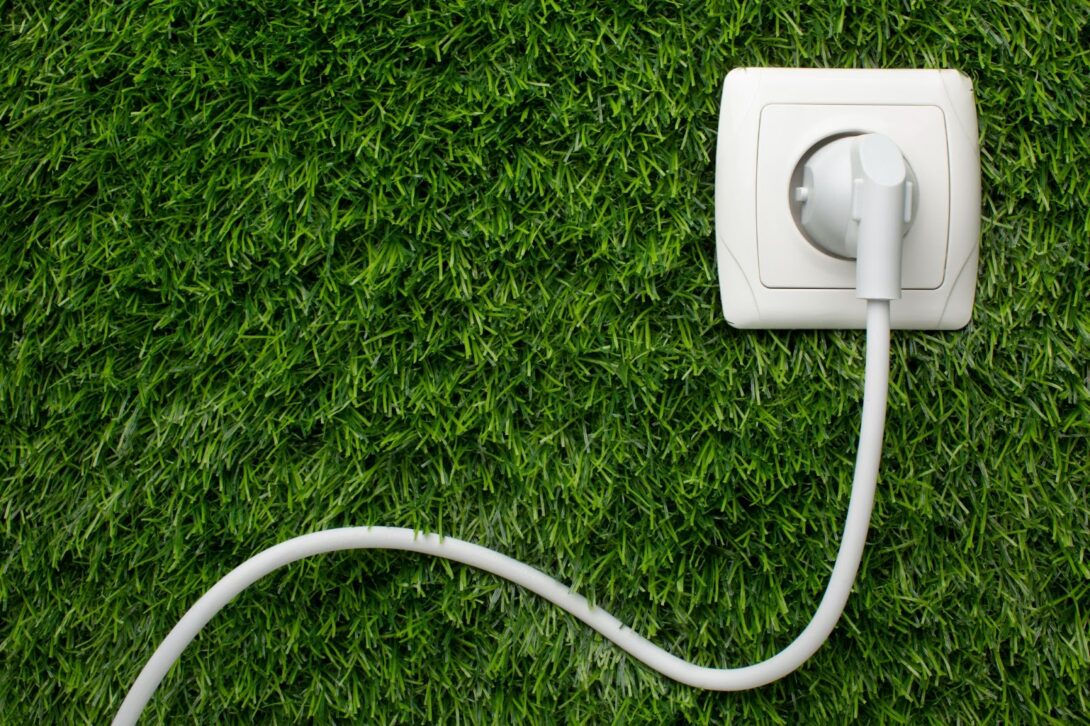
- Garden-Friendly Outlets: Choose outdoor outlets specifically designed for garden use, as they are more durable and resistant to moisture and soil;
- Buried Conduit: If you’re planning to install outlets within the garden, use buried conduit to protect the wiring and ensure safety. This also helps maintain a neat and unobtrusive garden appearance;
- Outlets with Ground Fault Protection: Just like in your patio or deck, use GFCI outlets in the garden to prevent electrical accidents;
- Zoning: Divide your garden into zones and install outlets strategically in each zone to ensure convenient access to power where you need it most. This can be particularly useful for powering irrigation systems or decorative garden lights.
Comprehensive Guide to Outlet Safety & Efficiency Enhancement
Childproofing Your Outlets
Children, with their natural curiosity, can often find themselves in precarious situations around household outlets. To ensure their safety and provide peace of mind to parents:
- Invest in Tamper-Resistant Receptacles: These outlets are specially designed to prevent foreign objects from being inserted, thus preventing shocks;
- Consider Outlet Covers or Plugs: These are easy-to-install solutions that cover the outlet holes, deterring children from inserting objects;
- Educate the Young Ones: While preventive measures are excellent, teaching children about the dangers of outlets and why they shouldn’t play with them is invaluable.
Rising Above with Elevated Outlets
In regions where flooding is a significant concern, protecting your home’s electrical system is crucial. Here are some suggestions:
- Position Outlets Above Potential Flood Levels: Ideally, outlets should be situated at least one foot above anticipated flood levels. This will help prevent water from reaching them during minor flooding events;
- Waterproof Outlet Covers: These covers can provide an added layer of protection against water intrusion;
- Regularly Review Local Flood Records: Being aware of the highest recorded flood levels in your area can help you make informed decisions about outlet placement.
Illuminate Your Hallways
Dark hallways can be hazardous, especially during nighttime. To ensure safer navigation:
- Opt for Nightlight Outlets: These outlets come with built-in lights that automatically turn on in low light conditions, illuminating the pathway;
- Motion-Sensor Options: Some modern outlets now come with motion sensors, lighting up only when someone approaches, saving energy;
- Choose LED Over Bulbs: LEDs are energy-efficient and have a longer lifespan than traditional bulbs. They also produce less heat, reducing fire risks.
With these detailed insights and recommendations, homeowners can make their living spaces safer and more efficient, reducing risks while increasing convenience.
Conclusion
Careful positioning of electrical outlets can profoundly enhance both the efficiency and security of your home. Adhering to these directives will enable you to optimize your electrical infrastructure’s utility while mitigating potential hazards. Prior to implementing any substantial alterations to your household’s electrical configuration, it is imperative to seek counsel from a certified electrician.

